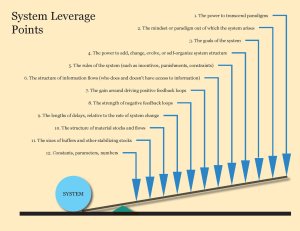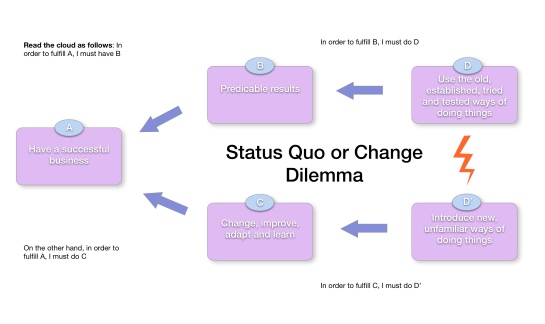Wants, Needs
My previous post seems to have struck a chord, judging by the number of retweets on Twitter. It also presents an opportunity to explore a perennial challenge of building things for other people: teasing out real needs from expressed wants.
Have you ever worked with business folks who articulate their wants in the form of solutions, rather than as solution-free “requirements”? As means rather than ends?
Let’s take another look at the list of desired outcomes (wants) appearing in the aforementioned post:
- A more coherent, disciplined approach to software development
- Improved governance and oversight
- Improved estimates
- Better due-date performance (reliable on-time delivery)
- More visibility into project roadmaps
- Common standards
- Better project organisation
- People working “in sync”
- Senior management confidence (in e.g. the teams’ ability to deliver)
- Higher staff motivation and engagement
Business Analysis for the Way the Work Works
From my days as a Business Analyst, I’ve learned that uncovering needs means having an ongoing dialogue with the people that matter. A dialogue in which we dig down, together, into the things they say they want, so as to uncover their real needs. Once we’ve teased apart the wants from the needs, we’re in a better place to choose effective strategies (solutions) for addressing those needs. Going with the superficial wants tends to box us in to the strategies (means) they provide. Strategies which often fall short of being effective.
I suspect what I’m talking about will become clearer as we examine in turn each item from the above list…
Item: A more coherent, disciplined approach to software development
This looks to me like a solution masquerading as a need. That’s to say “a more coherent, disciplined approach” seems like more like means to other ends, than and end in itself. What might those ends be? What might be the underlying needs driving this proposed solution? A dialogue with the people that matter seems in order here. A dialogue that could prove challenging, absent a degree of trust and willing collaboration. And even assuming we are all able to dig down towards the underlying needs, just as in building software there’s no guarantee we’ve identified those needs accurately, until we’ve built and delivered something and seen it “in production” long enough to gather some feedback. Active feedback, which also implies iteration and evolution: “Is this really meeting the needs of everyone that matters? Is it good enough yet? What else do we need to do to improve it further?” etc..
For illustration, I’ll take a stab at the needs which might underlie this want. Maybe some folks suppose that “a more coherent, disciplined approach” will bring order to the present chaos (a need for order). Maybe some folks suppose that “a more coherent, disciplined approach” will make delivery of e.g. features or product increments more predictable (a need for predictability).
Maybe productive and effective dialogue will uncover other latent needs implicit in this want.
Item: Improved governance and oversight
This also looks to me like a solution masquerading as a need.
Maybe some folks choose “Improved governance and oversight” as their automatic, default solution (strategy) for bring order to the present chaos (a need for order).
Item: Improved estimates
This again looks to me like a solution masquerading as a need.The No Estimates movement and debate has just about done this one to death. What might the supposed need for “improved estimates” imply. What’s really need here?
Item: Better due-date performance (reliable on-time delivery)
Whilst we could imagine this as yet another solution masquerading as a need, in this case I find this want more interesting, maybe closer to a real need than the previous two items.
I suspect some folks that matter may suppose that “better due date performance” is the obvious means to improve (external) customer satisfaction, and thereby revenue, repeat business, profit, market demand, market share, and other business metrics. Maybe those involved in the way the work works, armed with an explicit, agreed need to satisfy one or more specific business metrics, would be able to come up with ways of working which effectively address those metrics. In other words, valuable innovations.
Item: More visibility into project roadmaps
This again looks to me like a solution masquerading as a need. What might be the underlying need here? Maybe it’s something born of a feeling of powerlessness in the absence of information about what’s happening. Maybe it comes from a sense of frustration or embarrassment when having to face customers and investors expecting information about product release schedules, feature sets, and road maps. Whatever the case, an effective, productive dialogue may flush out some of those underlying feelings, and thereby lead to a better understanding of the needs we’re all trying to address.
Item: Common standards
Yet again this looks to me like a solution masquerading as a need. I’ve heard this want many times in numerous companies. This looks to me like an implicit solution to the question “how do we become more flexible, how can we cost-effectively deploy and redeploy our developers between projects and project teams as business priorities change?” I guess the people that matter suppose that “common standards” is the obvious answer. But it’s our job to understand the underlying need and come up with the most effective solution (strategy) for addressing it, not just the most common solution.
But I could be barking up the wrong tree about the presumed underlying need here, so I’d want to have conversations with the people that matter so as to really understand what they might be trying to achieve through addressing this want.
Item: Better project organisation
Another solution masquerading as a need. What might “better project organisation” bring us? Better due date performance? More visibility into project roadmaps and current status? See explanations, above, for the needs which might underlie *those* wants.
Item: People working “in sync”
Solution masquerading as a need. What might “people working in sync” bring us? Reduction in friction and waste? Improved flow (of products and features into the market)? Better due date performance? By digging down, though dialogue, we may uncover candidates for the underlying needs, which we can proceed to validate through delivering a way the work works, and getting feedback on the degree to which that way of working effectively addresses folks’ real needs.
Item: Senior management confidence (in e.g. the teams’ ability to deliver)
This is probably the one item in our list of sought outcomes that’s closest to a real need. We can intuit the scale of the problem (shortfall in senior management confidence) by looking at all the solutions they’re helpfully trying to provide us with, via the other items here. Solutions (masquerading as needs) that they believe will improve things and thereby deliver the boost in confidence they seek (and need). Ironically, the solutions they provide – being very much less effective solutions than those we can come up with for them, as experts – often undermine the very outcomes they seek.
Item: Higher staff motivation and engagement
Very laudable. But let’s not let the humanity of this want blind us to its nature as (yet another) solution masquerading as a need. What’s the end in mind? Why might the people that matter seek “higher staff motivation and engagement”?
So they can feel better about the culture for which they they feel responsible? As a means to increased throughput and thus improved revenues and profits? Again, until we know what they really need, any solutions we provide will likely fall well short of the mark. In other words, wasted effort.
Summary
So, we can see that taking “sought outcomes” at face value can lead us into sleepwalking into addressing superficial wants, and adopting other people’s (non-expert, relatively ineffective) solutions. Solutions which rate poorly on the effectiveness scale, and which in any case may well be addressing the wrong needs. I find it ironic just how much non-expert interference and micromanagement goes unnoticed, unchallenged and unlamented. Plenty of time for lamentation a year or two later.
Bottom line: When building software, the biggest risk lies in building the wrong thing (getting the requirements wrong), and it’s not any less of a risk when “building” – we might choose to call it “evolving” or even “engineering” – the way the work works.
– Bob



